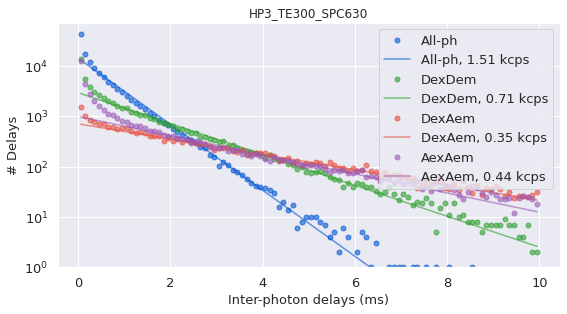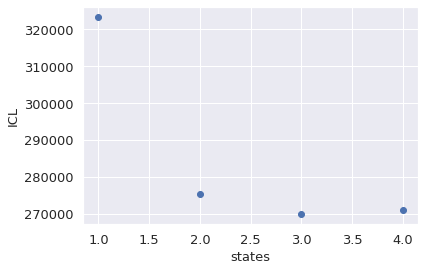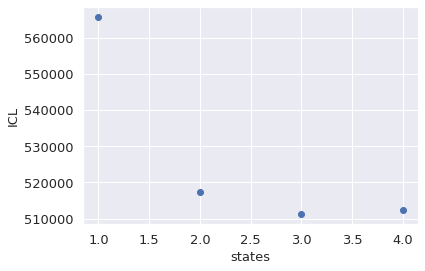Tutorial#
Note
Download the example file here: HP3_TE300_SPC630.hdf5
The basic workflow of burstH2MM is diagramed bellow:

To start the analysis of burst data with H2MM, we first need to process the data with FRETBursts, one of the dependencies of burstH2MM.
First let’s import the necessary modules:
[1]:
import numpy as np
from matplotlib import pyplot as plt
import fretbursts as frb
import burstH2MM as bhm
sns = frb.init_notebook()
- Optimized (cython) burst search loaded.
- Optimized (cython) photon counting loaded.
--------------------------------------------------------------
You are running FRETBursts (version 0.7.1).
If you use this software please cite the following paper:
FRETBursts: An Open Source Toolkit for Analysis of Freely-Diffusing Single-Molecule FRET
Ingargiola et al. (2016). http://dx.doi.org/10.1371/journal.pone.0160716
--------------------------------------------------------------
and load the data and search for bursts:
[2]:
filename = 'HP3_TE300_SPC630.hdf5'
# load the data into the data object frbdata
frbdata = frb.loader.photon_hdf5(filename)
Now it is best to check the alternation period etc.:
[3]:
# plot the alternation histogram
frb.bpl.plot_alternation_hist(frbdata)

If the alternation period looks good, we can apply the alternation period to assign Donor/Acceptor excitation to each photon:
[4]:
# if the alternation period is correct, apply data
frb.loader.alex_apply_period(frbdata)
# Total photons (after ALEX selection): 11,414,157
# D photons in D+A excitation periods: 5,208,392
# A photons in D+A excitation periods: 6,205,765
# D+A photons in D excitation period: 6,611,308
# D+A photons in A excitation period: 4,802,849
Then calculate the background rates used to set thresholds for finding bursts:
[5]:
# calcualte the background rate
frbdata.calc_bg(frb.bg.exp_fit, F_bg=1.7)
# plot bg parameters, to verify quality
frb.dplot(frbdata, frb.hist_bg)
- Calculating BG rates ... get bg th arrays
Channel 0
[DONE]
[5]:
<AxesSubplot:title={'center':'HP3_TE300_SPC630'}, xlabel='Inter-photon delays (ms)', ylabel='# Delays'>

And finally search for bursts and refine the selection by appropriate burst size/width/other parameters:
[6]:
# now perform burst search
frbdata.burst_search(m=10, F=6)
# make sure to set the appropriate thresholds of ALL size
# parameters to the particulars of your experiment
frbdata_sel = frbdata.select_bursts(frb.select_bursts.size, th1=50)
frb.alex_jointplot(frbdata_sel);
- Performing burst search (verbose=False) ...[DONE]
- Calculating burst periods ...[DONE]
- Counting D and A ph and calculating FRET ...
- Applying background correction.
[DONE Counting D/A]
<class 'matplotlib.figure.Figure'>

H2MM analysis#
Now that the data is selected, we can segment the photons into bursts, which will be stored in a BurstData object:
[7]:
bdata = bhm.BurstData(frbdata_sel)
bdata is now the object that will organize the downstream information for optimization. When bdata was created, it automatically also generated a H2MM_list object, stored in BurstData.models which is where we can perform the H2MM optimizations.
So let’s run a round of optimizations:
[8]:
# calculate models
bdata.models.calc_models()
The model converged after 2 iterations
The model converged after 35 iterations
The model converged after 122 iterations
The model converged after 404 iterations
[8]:
2
Choosing best model#
When you run this, it will optimize H2MM models over a range of states. The next task is to select the ideal number of states. To select this, there are several options, but for now we will use the Integrated Complete Likelihood (ICL). The model with the minimal ICL is usually the best model:
[9]:
bhm.ICL_plot(bdata.models);

Inspecting results#
Now that the ideal model has been identified, we can plot the E/S values of each dwell with dwell_ES_scatter() , with dwells colored by state.
We can also overlay the E/S values derived from the H2MM result over the dwell values with the scatter_ES() function, and add in arrows connecting the states with trans_arrow_ES() function.
Note that we pass the
s=75, c='r', ec='k'arguments to thescatter_ES()function, which ensure the size of the points is appropriate, as well as making the color popThere are many more plotting functions. You can review these in the Plotting module.
[10]:
# plot the dwell ES of the result
bhm.dwell_ES_scatter(bdata.models[2])
# overlay with the main values,
bhm.scatter_ES(bdata.models[2], s=75, c="r", ec='k')
# plot arrows and transition rates
bhm.trans_arrow_ES(bdata.models[2]);

We can also view the E and S values of the model with the H2MM_result.E and H2MM_result.S properties as numpy arrays:
[11]:
bdata.models[2].E, bdata.models[2].S
[11]:
(array([0.66031034, 0.15955158, 0.06730048]),
array([0.43073408, 0.55348988, 0.9708039 ]))
We can also view the transition probability matrix as a numpy array with the H2MM_result.trans property:
[12]:
bdata.models[2].trans
[12]:
array([[1.99994147e+07, 5.31727384e+02, 5.35449335e+01],
[2.05278796e+02, 1.99996914e+07, 1.03279314e+02],
[7.90906719e+00, 1.16271242e+02, 1.99998758e+07]])
burstH2MM attempts to calculate the most common dwell parameters, and to allow for intelligent selection of different sorts of dwells/bursts and do most of the heavy lifting for the user. These are nearly all stored as attributes in H2MM_result objects.
Further plotting and customization#
This dwell based ES plot from before looked nice, however, the dimensions were a bit odd, usually these types of plots are square.
Matplotlib has the plt.subplots() function, which let’s use make a figure with a grid of subplots and specify the figure’s size.
All plotting functions in burstH2MM have an ax keyword argument, which takes a matplotlib axes ( matplotlib.axes._subplots.AxesSubplot ), which specifies the axes where the plot will be drawn, (this is essentially the same as how seaborn and even FRETBursts operate).
Therefore we can easily use plt.subplots() to make a figure and axes, the latter of which to give to our plotting functions:
[13]:
fig, ax = plt.subplots(figsize=(5,5))
# plot the dwell ES of the result
bhm.dwell_ES_scatter(bdata.models[2])
# overlay with the main values,
bhm.scatter_ES(bdata.models[2], s=75, c="r", ec='k')
# plot arrows and transition rates
bhm.trans_arrow_ES(bdata.models[2]);

ES plots are great, but sometimes we like to see 1D histograms.
For that we have the dwell_E_hist() , dwell_S_hist functions to plot dwell based histograms.
Then we have axline_E and axline_S to plot vertical or horizontal bars instead of the points we have for the model values.
Since we have two types of histograms to plot, let’s take advantage of having multiple subplots in 1 figure and call plt.subplots(ncols=2, figsize=(12,5)) to make a figure with 2 plots side-by-side (2 columns), with dimensions 12 in x 4 in.
[14]:
fig, ax = plt.subplots(ncols=2, figsize=(12,4))
# plot E histogram in 1st subplot
bhm.dwell_E_hist(bdata.models[2], ax=ax[0])
bhm.axline_E(bdata.models[2], ax=ax[0])
# plot S histogram in 2nd subplot
bhm.dwell_S_hist(bdata.models[2], ax=ax[1])
bhm.axline_S(bdata.models[2], ax=ax[1]);

We can even rotate these plots by 90 degrees, using the orientation='horizontal and horizontal=True keyword arguments for the dwell based histograms and state based lines arguments respectively.
Putting this all together we can make a plot that mimics the fretbursts.alex_jointplot() function:
[15]:
# make plot with 2 rows and 2 columns
fig, ax = plt.subplots(nrows=2, ncols=2, figsize=(12,12))
# plot the dwell ES of the result
bhm.dwell_ES_scatter(bdata.models[2], ax=ax[1,0])
# overlay with the main values,
bhm.scatter_ES(bdata.models[2], s=75, c="r", ec='k', ax=ax[1,0])
# plot arrows and transition rates
bhm.trans_arrow_ES(bdata.models[2], ax=ax[1,0])
# plot E histogram in 1st subplot
bhm.dwell_E_hist(bdata.models[2], ax=ax[0,0]) # ax[0,0] so place in upper left corner
bhm.axline_E(bdata.models[2], ax=ax[0,0])
# plot S histogram in 2nd subplot
bhm.dwell_S_hist(bdata.models[2], ax=ax[1,1], orientation='horizontal') # ax[1,1] so place in upper left corner
bhm.axline_S(bdata.models[2], ax=ax[1,1], horizontal=True);
# silence the unused axis
ax[0,1].axis('off');

Uncertainty Estimation#
Another question is quantifying the error, or uncertainty of the model parameter values.
There are two means to do this: 1. the loglikelihood uncertainty 2. Bootstrap method
Both wind up being somewhat time consuming, as they require evaluating models. But the scale differently, the lgolikelihood uncertainty is relatively light per model parameter, but that number grows with the square of the states. This can be somewhat overcome, as you can just evaluate the uncertainty for the subset of the parameters you are interested in. On the other hand, the bootstrap method requires several optimizations of subsets of data, so it tends to take longer, but doesn’t grow as fast for larger numbers of states.
Loglikelihood Uncertainty#
Loglikelihood uncertainty can be accessed through the H2MM_result.loglik_err attribute, which is a special class, the ModelError.Loglik_Error class, which coordinates the calculation and organization of all loglikelihood uncertainty information and calculations.
To calculate a given value, you can use one of the following methods: ModelError.Loglik_Error.get_E_err() , ModelError.Loglik_Error.get_S_err() , and ModelError.Loglik_Error.get_trans_err() .
ModelError.Loglik_Error.get_E_err() , and ModelError.Loglik_Error.get_S_err() take a single argument, which is the state for which you want to evaluate the uncertainty.
The return value is the estimated uncertainty.
[16]:
bdata.models[2].loglik_err.get_E_err(1)
[16]:
0.001923828124999985
ModelError.Loglik_Error.get_trans_err() works a little differently, since the transition rates mark just that: a transition from a state to another state, so instead, this function takes two arguments, the “from state” and “to state” argument.
Transition rates tend to distribute differently, so instead of returning just a single value for the uncertainty, a 2 element array is returend with lower and upper bounds of the estimated error.
[17]:
bdata.models[2].loglik_err.get_trans_err(0,1)
[17]:
masked_array(data=[501.8586074655524, 562.3569445639647],
mask=[False, False],
fill_value=inf)
Boostrap Uncertainty#
The boostrap uncertainty works by subdividing the data into subsets and running optimizations on those subsets, and finally taking the standard deviation of the model parameters across the optimizations of the subsets.
Since this can take some time, before accessing these values, we run the H2MM_result.bootstrap_eval() method to calculate the uncertanty.
[18]:
bdata.models[2].bootstrap_eval()
The model converged after 1987 iterations
The model converged after 405 iterations
The model converged after 193 iterations
The model converged after 231 iterations
The model converged after 203 iterations
The model converged after 260 iterations
The model converged after 306 iterations
The model converged after 407 iterations
The model converged after 282 iterations
The model converged after 224 iterations
[18]:
(array([[109.28690798, 108.97205588, 70.31510773],
[ 47.38608221, 64.09946195, 33.97985691],
[ 16.00785918, 33.65214868, 34.29002879]]),
array([0.03168643, 0.00606686, 0.00233699]),
array([0.02549997, 0.0118141 , 0.00361265]))
Then we can access the values through the H2MM_result.E_std_bs , H2MM_result.S_std_bs , and H2MM_result.trans_std_bs .
[19]:
bdata.models[2].E_std_bs, bdata.models[2].S_std_bs
[19]:
(array([0.03168643, 0.00606686, 0.00233699]),
array([0.02549997, 0.0118141 , 0.00361265]))
[20]:
bdata.models[2].trans_std_bs
[20]:
array([[109.28690798, 108.97205588, 70.31510773],
[ 47.38608221, 64.09946195, 33.97985691],
[ 16.00785918, 33.65214868, 34.29002879]])
Divisor Approach#
burstH2MM also allows the H2MM input data to incorporate photon nanotimes using the divisor approach. Before using divisors, and therefore nanotimes, it is best to analyze the lifetime decays, and set appropriate thresholds for the IRF of each stream, so we will first plot the decays.
Note
We are applying these nanotime settings to bdata , the original BurstData object created at the beginning of the tutorial. This is because these are universal settings for all H2MM_list objects created from their parent BurstData object.
As such, these settings are “remembered” through all children of bdata.
[21]:
bhm.raw_nanotime_hist(bdata)
[21]:
([[<matplotlib.lines.Line2D at 0x7f7a74be9ca0>],
[<matplotlib.lines.Line2D at 0x7f7a74be99d0>],
[<matplotlib.lines.Line2D at 0x7f7a74be9400>]],
<matplotlib.legend.Legend at 0x7f7a74be93d0>)

Now we can choose the best thresholds for the IRF, and we will set the BurstData.irf_thresh attribute.
Note
The order of thresholds corresponds to the order of streams in BurstData.ph_strearms is the order of threshold in BurstData.irf_thresh
[22]:
bdata.irf_thresh = np.array([2355, 2305, 220])
Now that the IRF thresholds have been set, we should have no problems down the road when calculating dwell mean nanotimes and other such parameters.
We are now ready to actually start using the divisor approach. First a new divisor must be set:
[23]:
div_name = bdata.auto_div(1)
This creates a new divisor based H2MM_list object stored in the dictionary BurstData.div_models with the key returned by the function (stored in div_name ). So let’s extract the H2MM_list object generated, and then run an optimization:
[24]:
# run H2MM analysis
bdata.div_models[div_name].calc_models()
The model converged after 2 iterations
The model converged after 28 iterations
The model converged after 78 iterations
The model converged after 397 iterations
[24]:
2
Next, as before, we need to look at the ICL, to choose the ideal model
[25]:
bhm.ICL_plot(bdata.div_models[div_name])
[25]:
[<matplotlib.collections.PathCollection at 0x7f7a74cfb7c0>]

The 3 state model again looks like the best fit, so we will reference it with index 2 (remember python indexes from 0).
Now we can finally plot the distribution of nanotimes per state. For this there is the dwell_tau_hist()
[26]:
bhm.dwell_tau_hist(bdata.div_models[div_name][2])
[26]:
[[<BarContainer object of 10 artists>],
[<BarContainer object of 10 artists>],
[<BarContainer object of 10 artists>]]

And that concludes this tutorial, thank you for your interest in burstH2MM.
Download this documentation as a jupyter notebook here: Tutorial.ipynb